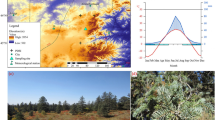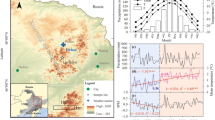Abstract
Using woody plant phenological data in the Beijing Botanical Garden from 1979 to 2013, we revealed three levels of phenology rhythms and examined their coherence with temperature rhythms. First, the sequential and correlative rhythm shows that occurrence dates of various phenological events obey a certain time sequence within a year and synchronously advance or postpone among years. The positive correlation between spring phenophase dates is much stronger than that between autumn phenophase dates and attenuates as the time interval between two spring phenophases increases. This phenological rhythm can be explained by positive correlation between above 0 °C mean temperatures corresponding to different phenophase dates. Second, the circannual rhythm indicates that recurrence interval of a phenophase in the same species in two adjacent years is about 365 days, which can be explained by the 365-day recurrence interval in the first and last dates of threshold temperatures. Moreover, an earlier phenophase date in the current year may lead to a later phenophase date in the next year through extending recurrence interval. Thus, the plant phenology sequential and correlative rhythm and circannual rhythm are interacted, which mirrors the interaction between seasonal variation and annual periodicity of temperature. Finally, the multi-year rhythm implies that phenophase dates display quasi-periodicity more than 1 year. The same 12-year periodicity in phenophase and threshold temperature dates confirmed temperature controls of the phenology multi-year rhythm. Our findings provide new perspectives for examining phenological response to climate change and developing comprehensive phenology models considering temporal coherence of phenological and climatic rhythmicity.




Similar content being viewed by others
References
Ahas H, Aasa A (2003) Developing comparative phenological calendars. In: Schwartz MD (ed) Phenology: an integrative environmental Science. Kluwer Academic Publishers, Dordrecht, pp 301–318
Chen XQ (1994) Untersuchung zur zeitlich-räumlichen Ähnlichkeit von phänologischen und klimatologischen Parametern in Westdeutschland und zum Einfluß geoökologischer Faktoren auf die phänologische Entwicklung im Gebiet des Taunus. Selbstverlag des Deutschen Wetterdienstes, Offenbach am Main, pp 116
Chen XQ, Pan WF (2002) Relationships among phenological growing season, time-integrated normalized difference vegetation index and climate forcing in the temperate region of eastern China. Int J Climatol 22:1781–1792
Chen XQ, Xu L (2012) Phenological responses of Ulmus pumila (Siberian Elm) to climate change in the temperate zone of China. Int J Biometeorol 56:695–706
Chen XQ (2017) Spatiotemporal processes of plant phenology: simulation and prediction. Springer-Verlag GmbH Germany, Berlin
Chmielewski FM, Rötzer T (2001) Response of tree phenology to climate change across Europe. Agric For Meteorol 108:101–112
Chuine I, Kramer K, Hänninen H (2003) Plant development models. In: Schwartz MD (ed) Phenology: an integrative environmental science. Kluwer Academic Publishers, Dordrecht, pp 217–235
Cleland EE, Chiariello NR, Loarie SR, Mooney HA, Field CB (2006) Diverse responses of phenology to global changes in a grassland ecosystem. Proc Natl Acad Sci U S A 103:13740–21374
Delpierre N, Dufrêne E, Soudani K, Ulrich E, Cecchini S, Boé J, François C (2009) Modelling interannual and spatial variability of leaf senescence for three deciduous tree species in France. Agric For Meteorol 149:938–948
Dufrêne E, Davi H, François C, Maire G, Dantec VL, Granier A (2005) Modelling carbon and water cycles in a beech forest: part I: model description and uncertainty analysis on modelled NEE. Ecol Model 185:407–436
Editorial Committee of the China's agriculture encyclopedia (1986) The China's agriculture encyclopedia: agricultural meteorology. Agriculture Press, Beijing, pp170
Fu YSH, Campioli M, Vitasse Y, De Boeck HJ, van den Berge J, Abdelgawad H, Asard H, Piao SL, Deckmyn G, Janssens IA (2014) Variation in leaf flushing date influences autumnal senescence and next year's flushing date in two temperate tree species. Proc Natl Acad Sci U S A 111:7355–7360
Gordo O, Sanz JJ (2010) Impact of climate change on plant phenology in Mediterranean ecosystems. Glob Change Biol 16:1082–1106
Heide O, Prestrud A (2005) Low temperature, but not photoperiod, controls growth cessation and dormancy induction and release in apple and pear. Tree Physiol 25:109–114
Hudson IL, Keatley MR (2010) Singular spectrum analysis: climatic niche identification. In: Hudson IL, Keatley MR (eds) Phenological research: methods for environmental and climate change analysis. Springer, Dordrecht, pp 393–424
Jiang JM, Zhang DE, Fraedrich K (1997) Historic climate variability of wetness in East China (960-1992): a wavelet analysis. Int J Climatol 17:969–981
Keeling CD, Chin JFS, Whorf TP (1996) Increased activity of northern vegetation inferred from atmospheric CO2 measurements. Nature 382:146–149
Kramer K (1994) Selecting a model to predict the onset of growth of Fagus sylvatica. J Appl Ecol 31:172–181
Matsumoto K, Ohta T, Irasawa M, Nakamura T (2003) Climate change and extension of the Ginkgo biloba L. growing season in Japan. Glob Change Biol 9:1634–1642
Menzel A (2003) Plant phenological anomalies in Germany and their relation to air temperature and NAO. Clim Chang 57:243–263
Margary ID (1926) The Marsham phenological record in Norfolk, 1736–1925, and some others. Quart J Roy Meteorol Soc 22:27–54
Newman JE, Beard JB (1962) Phenological observations: the dependent variable in bioclimatic and agrometeorological studies. Agron J 54:399–403
Larcher W (1975) Physiological plant ecology. Springer, Berlin Heidelberg New York, pp219–234
Peñuelas J, Rutishauser T, Filella I (2009) Phenology feedbacks on climate change. Science 324:887–888
Pfau R (1964) Varianz- und Korrelationsanalytische Untersuchungen an Phänologischen Phases im Naturraum 06 (unterbayerisches Hügelland). Meteorol Rundsch 17:113–122
Piao SL, Ciais P, Friedlingstein P, Peylin P, Reichstein M, Luyssaert S, Margolis H, Fang JY, Barr A, Chen AP, Grelle A, Hollinger DY, Laurila T, Lindroth A, Richardson AD, Vesala T (2008) Net carbon dioxide losses of northern ecosystems in response to autumn warming. Nature 451:49–52
Reaumur RAF (1735) Observations du thermomètre, faites à Paris pendant l’année 1735, comparées avec celles qui ont été faites sous la ligne, à l’isle de France, à Alger et quelques unes de nos isles de l'Amérique. Mem Paris Acad Sci 1735:545
Richardson AD, Keenana TF, Migliavaccab M, Ryu Y, Sonnentaga O, Toomeya M (2013) Climate change, phenology, and phenological control of vegetation feedbacks to the climate system. Agric For Meteorol 169:156–173
Schwartz MD, Crawford TM (2001) Detecting energy balance modifications at the onset of spring. Phys Geogr 22:394–409
Sparks TH, Carey PD (1995) The responses of species to climate over two centuries: an analysis of the Marsham phenological record, 1736-1947. J Ecol 83:321–329
Sparks TH, Jeffree EP, Jeffree CE (2000) An examination of the relationship between flowering times and temperature at the national scale using long-term phenological records from the UK. Int J Biometeorol 44:82–87
Torrence C, Compo GP (1998) A practical guide to wavelet analysis. B Am Meteorol Soc 79:61–78
Wan M, Liu X (1979) Method of Chinese phenological observation (in Chinese). Science Press, Beijing
Yang G, Chen X (1995) Phenological calendars and their applications in the Beijing area (in Chinese). Capital Normal University Press, Beijing
Acknowledgments
The authors wish to thank the Meteorological Information Center of the China Meteorological Administration for providing phenological data. This research is funded by the National Natural Science Foundation of China under Grant No. 41471033.
Author information
Authors and Affiliations
Corresponding author
Rights and permissions
About this article
Cite this article
Chen, X., Zhang, W., Ren, S. et al. Temporal coherence of phenological and climatic rhythmicity in Beijing. Int J Biometeorol 61, 1733–1748 (2017). https://doi.org/10.1007/s00484-017-1355-8
Received:
Revised:
Accepted:
Published:
Issue Date:
DOI: https://doi.org/10.1007/s00484-017-1355-8




